"Quick and Flavorful Pressure Cooker Vegetable Biryani: A Delightful One-Pot Recipe"
Indulge in the aromatic flavors of a delightful and wholesome dish - Pressure Cooker Vegetable Biryani! This one-pot wonder brings together the goodness of Basmati rice, an assortment of fresh vegetables, and a blend of aromatic spices, all cooked to perfection in a pressure cooker. With its quick preparation and mouthwatering taste, this vegetable biryani is the perfect choice for a delicious weeknight dinner or a special gathering with friends and family. Join us on this culinary adventure as we explore the magic of creating an authentic biryani in just a fraction of the time, without compromising on its rich taste and exquisite aroma. Get ready to savor every delectable spoonful of this easy-to-make, yet utterly satisfying, Pressure Cooker Vegetable Biryani!
Exploring the Scrumptious Delight of Vegetable Biryani
Vegetable Biryani is a cherished culinary masterpiece that hails from the Indian subcontinent, renowned for its enticing flavors and aromatic appeal. This delectable dish is a celebration of perfectly cooked Basmati rice, tender and colorful mixed vegetables, and a harmonious blend of aromatic spices, all lovingly layered together.
At its core, Vegetable Biryani is a delightful rice-based dish that beautifully combines the earthiness of vegetables with the rich, fragrant notes of spices like cumin, cinnamon,
amom, and cloves. The ingredients are meticulously prepared and assembled to create a symphony of flavors that entice the senses.
This savory creation is not just a feast for the palate but also a visual delight, with its vibrant hues and the sight of perfectly cooked rice grains nestled among the tender vegetables. The cooking process is a testament to the art of layering, where each ingredient is carefully added to the pot, allowing the flavors to intermingle and create a harmonious fusion.
The process of preparing Vegetable Biryani is an experience in itself. From soaking the Basmati rice to sautéing the spices, each step contributes to the depth and complexity of the final dish. Whether cooked traditionally over an open flame or conveniently in a modern pressure cooker, the end result remains equally enticing.
Vegetable Biryani's versatility is another aspect that adds to its allure. It can be customized to suit various tastes and dietary preferences, making it a delightful option for both vegetarians and non-vegetarians alike. The addition of nuts, dried fruits, and saffron-infused milk further elevates its appeal and transforms it into a truly indulgent affair.
This iconic dish finds its place on special occasions, celebrations, and family gatherings, where it takes center stage on the dining table, inviting everyone to partake in its splendor. The aroma of the biryani wafts through the air, inviting eager appetites to experience a symphony of flavors with each spoonful.
In conclusion, Vegetable Biryani is more than just a dish; it is an embodiment of culture, tradition, and culinary artistry. With its aromatic spices, tender vegetables, and perfectly cooked rice, it remains a timeless classic that brings joy and satisfaction to all who savor its flavors. Whether it's a lavish feast or a simple weekday dinner, Vegetable Biryani is always a welcome addition, creating cherished memories with every delicious bite.
"Vegetable Biryani: A Culinary Journey Through History and Origins"
The history and origins of Vegetable Biryani are deeply rooted in the culinary heritage of the Indian subcontinent. Biryani, in general, is believed to have originated in Persia and was introduced to the Indian subcontinent during the reign of Mughal emperors in the 16th century. Over the centuries, it evolved and adapted to the diverse regional cuisines of the Indian subcontinent, resulting in various regional variations of this beloved dish.
The Mughals, known for their opulent lifestyle and refined taste in food, played a significant role in popularizing Biryani in India. It is said that they brought the concept of layered rice and meat dishes from Persia and gave it a unique Indian twist by incorporating local spices, herbs, and ingredients.
Initially, Biryani was considered a regal delicacy served in the royal courts and during grand feasts. The dish was prepared with tender meat, fragrant rice, and a harmonious blend of aromatic spices, creating a sumptuous and luxurious culinary experience.
As time passed, Biryani traveled from the royal kitchens to the streets and homes of the common people. The traditional meat-based Biryani soon embraced vegetarian versions, including Vegetable Biryani, to cater to a diverse range of palates and dietary preferences.
The coastal regions of India further enriched the culinary landscape by incorporating locally available vegetables, seafood, and unique spices into the preparation of Biryani. Each region developed its own distinct style of Biryani, reflecting the cultural diversity and culinary traditions of that area.
Vegetable Biryani, in particular, gained popularity among vegetarians and those seeking a lighter and more wholesome alternative to the meat-based versions. Its ability to showcase an array of colorful vegetables, aromatic spices, and fragrant Basmati rice made it an instant hit in Indian households and restaurants alike.
Today, Vegetable Biryani stands as a beloved and cherished dish, celebrated during festivals, family gatherings, and special occasions across the Indian subcontinent and beyond. Its rich history and diverse origins continue to be celebrated, making it a culinary symbol of India's vibrant culture and tradition. Whether prepared in the traditional manner or with modern twists, Vegetable Biryani remains a timeless classic that continues to captivate the taste buds of food enthusiasts around the world.
"From North to South, East to West: Exploring the Diverse Regional Variations of Vegetable Biryani"
The culinary journey of Vegetable Biryani across the vast expanse of the Indian subcontinent has given rise to an array of diverse regional variations, each with its own unique blend of flavors and techniques. From the northern plains to the coastal regions and the southern tip of India, every corner boasts its distinct interpretation of this beloved dish.
North Indian Vegetable Biryani: Hailing from the heart of the Mughal Empire, the North Indian version of Vegetable Biryani is rich and aromatic. Layered with fragrant Basmati rice, a medley of colorful vegetables, and a symphony of spices, this biryani exudes regal charm. Often garnished with saffron-infused milk and served with creamy raita, the North Indian Vegetable Biryani is a testament to the opulence of Mughlai cuisine.
Hyderabadi Vegetable Biryani: Traveling south to the city of Nizams, Hyderabad, we encounter the iconic Hyderabadi Vegetable Biryani. Characterized by its "Dum Pukht" cooking technique, where the rice and vegetables are slow-cooked in a sealed pot, this biryani is a delightful blend of tangy, spicy, and fragrant flavors. Topped with fried onions, fresh herbs, and boiled eggs, the Hyderabadi Vegetable Biryani is a celebration of flavors and textures.
Awadhi Vegetable Biryani: Originating from the princely state of Awadh, now known as Lucknow, the Awadhi Vegetable Biryani is a true masterpiece of culinary finesse. Prepared using the "Pakki Biryani" method, where the vegetables and partially cooked rice are layered and then further cooked together, this biryani boasts a subtle and elegant taste. Enriched with saffron, rose water, and ghee, the Awadhi Vegetable Biryani is a delightful indulgence.
Kolkata Biryani: Moving towards the eastern shores, we encounter the Kolkata Biryani, a unique amalgamation of flavors inspired by Awadhi and Bengali cuisines. Known for its mild and aromatic taste, this biryani features potatoes alongside the vegetables, adding a distinct touch to the dish. Served with boiled eggs and a side of sweet chutney, the Kolkata Biryani is a delightful fusion of cultures.
South Indian Vegetable Biryani: In the southern regions, Vegetable Biryani takes on a delightful twist. Prepared with fragrant spices, coconut milk, and a bounty of local vegetables, the South Indian version is a burst of flavors and a celebration of regional ingredients. Served with tangy tomato or coconut-based chutneys, the South Indian Vegetable Biryani is a feast for the senses.
Sindhi Biryani: Moving westward, we encounter the rich and flavorful Sindhi Biryani. Influenced by the culinary traditions of Sindh, now a part of Pakistan, this biryani features an abundance of vegetables, aromatic spices, and tangy yogurt-based marinades. Topped with fried onions, raisins, and almonds, the Sindhi Vegetable Biryani is a delightful medley of sweet and savory notes.
These regional variations of Vegetable Biryani are a testament to the diversity of Indian cuisine, each showcasing the unique flavors and cooking techniques of their respective regions. Whether it's the opulence of the north, the Dum Pukht of Hyderabad, the subtlety of Awadh, the fusion of Kolkata, the vibrancy of the south, or the richness of Sindhi, each rendition of Vegetable Biryani promises an unforgettable culinary experience. As this cherished dish continues to evolve with time, it remains a true reflection of India's culinary heritage and the passion for creating unforgettable flavors on a plate.
"Preserving Tradition or Embracing Efficiency: Traditional vs. Modern Cooking Methods for Vegetable Biryani"
In the culinary world, the preparation of Vegetable Biryani offers two distinct approaches: traditional and modern cooking methods. Both methods have their merits and cater to different preferences and lifestyles.
Traditional Cooking Method:
The traditional method of preparing Vegetable Biryani follows time-honored techniques that have been passed down through generations. It involves a more labor-intensive process that requires attention to detail and patience. Here's an overview of the traditional method:
a. Layered Cooking: In the traditional approach, the Biryani is assembled in layers. Par-cooked Basmati rice and partially cooked vegetables are carefully layered with aromatic spices, fried onions, and fresh herbs. Each layer contributes to the overall flavor and texture of the final dish.
b. Dum Cooking: Dum cooking is a slow-cooking technique that involves sealing the pot with dough or cloth, creating a steam-filled environment. This allows the flavors to meld together harmoniously, resulting in a rich and fragrant Biryani. The pot is placed over a low flame or in an oven, allowing the Biryani to cook to perfection over a longer period.
c. Patience and Expertise: The traditional method demands skill and patience from the cook. Timing and heat control are crucial to ensure that the rice is fluffy, the vegetables are tender, and the spices infuse perfectly.
d. Occasions and Celebrations: Traditional Biryani preparation is often reserved for special occasions, family gatherings, and celebrations where the time and effort invested are a part of the overall experience.
Modern Cooking Method:
In contrast, modern cooking methods cater to the fast-paced lifestyle of the modern world, offering convenience and efficiency. The modern approach to preparing Vegetable Biryani is more streamlined and accessible, with several options available:
a. One-Pot Cooking: With modern pressure cookers, the Biryani can be cooked in a single pot, significantly reducing cooking time. The pressure cooker creates a pressurized environment, hastening the cooking process and infusing flavors effectively.
b. Simplified Layering: Instead of the elaborate layering of traditional Biryani, modern recipes may combine the ingredients in a single layer, making the preparation less time-consuming.
c. Versatility: Modern methods allow for easy customization and experimentation, enabling cooks to adapt the Biryani to personal preferences by adjusting spice levels and vegetable choices.
d. Quick Weeknight Meals: The modern cooking method is perfect for busy weeknights when time is limited, yet the desire for a delicious and satisfying meal remains.
Both traditional and modern cooking methods for Vegetable Biryani have their place in the culinary landscape. The traditional approach honors time-honored techniques and brings a sense of heritage to the table, making it perfect for special occasions and celebratory gatherings. On the other hand, the modern approach embraces efficiency and convenience, making Vegetable Biryani accessible for everyday cooking. Whether following the traditions of the past or embracing the modern lifestyle, both methods promise a delightful and aromatic Vegetable Biryani experience.
"Savor the Richness: Vegetable Biryani - A Mélange of Flavors"
- Basmati rice: The primary ingredient and base of the dish, providing the distinct long-grain texture and delicate aroma characteristic of Biryani.
- Mixed vegetables (carrots, beans, peas, potatoes, etc.): Adds color, texture, and nutrition to the biryani, making it a wholesome and flavorful vegetarian option.
- Onion: Adds a sweet and savory flavor base to the biryani when sautéed, enhancing the overall taste.
- Green chilies: Adds spiciness and a subtle heat to the dish, balancing the flavors with a slight kick.
- Ginger garlic paste: Provides a robust and aromatic flavor, infusing the biryani with the quintessential Indian taste.
- Plain yogurt: Acts as a natural tenderizer for the vegetables and rice while adding a creamy and tangy element to the biryani.
- Mint leaves: Imparts a refreshing and cooling flavor to the biryani, complementing the spices and vegetables.
- Cilantro (coriander leaves): Adds a fresh and earthy note to the dish, enhancing its overall aroma and presentation.
- Fried onions (optional, for garnish): Adds a crispy and flavorful topping, elevating the visual appeal and taste.
- Ghee or vegetable oil: Used for sautéing the spices and onions, providing richness and depth of flavor to the biryani.
- Cumin seeds, cinnamon stick, green cardamom pods, whole cloves, and bay leaf: The aromatic spices that infuse the biryani with their distinct flavors, creating a rich and enticing aroma.
- Garam masala: A blend of warm and aromatic spices that enhance the overall taste and complexity of the dish.
- Turmeric powder: Adds a vibrant yellow color to the biryani and imparts a subtle earthy flavor.
- Red chili powder: Provides a spicy kick to the biryani, which can be adjusted according to personal spice preferences.
- Salt: Enhances the flavors of the vegetables and spices, ensuring a well-balanced taste.
- Water: Used for cooking the rice and vegetables, ensuring they are perfectly cooked.
- Saffron strands soaked in warm milk: Adds a delicate and aromatic saffron flavor, infusing the biryani with an inviting fragrance and a touch of luxury.
- Lemon juice: Provides a tangy and citrusy note to the biryani, brightening the flavors and adding a zesty element.
Each ingredient plays a crucial role in contributing to the distinct taste and texture of Vegetable Biryani, creating a harmonious and flavorful dish loved by many.
"Time-Saving and Flavor-Enhancing: The Benefits of Pressure Cooking Biryani"
Pressure cooking has become a popular and practical method for preparing Vegetable Biryani due to its numerous benefits. This cooking technique not only saves valuable time but also enhances the flavors and textures of the dish.
Quick Preparation: One of the main reasons to choose pressure cooking for Biryani is its speed. Compared to traditional methods, pressure cooking significantly reduces the cooking time. The high-pressure environment allows the ingredients to cook faster, making it an ideal choice for busy weekdays or when you're craving a delicious meal without spending hours in the kitchen.
Retains Nutrients: Pressure cooking preserves the essential nutrients in the vegetables and rice. The sealed environment prevents loss of water-soluble vitamins and minerals, ensuring that your Vegetable Biryani remains not only flavorful but also nutritious.
Intensified Flavors: The pressurized steam infuses the ingredients, resulting in a more concentrated and robust flavor profile. The aromatic spices and herbs meld together, creating a tantalizing and aromatic dish that entices the senses with every bite.
Even Cooking: Pressure cooking ensures even distribution of heat, preventing the rice from sticking to the bottom of the pot and eliminating the need for continuous stirring. This consistent heat circulation ensures that each grain of Basmati rice is perfectly cooked, fluffy, and separate.
Moisture Retention: The sealed pressure cooker traps steam, preventing the escape of moisture. This helps to retain the natural juices of the vegetables, making them tender and succulent, while also preventing the rice from becoming dry.
One-Pot Wonder: Pressure cooking allows you to prepare the entire Vegetable Biryani in one pot, simplifying the cooking process and reducing the number of dishes to clean afterward. This convenience makes it a great choice for everyday cooking and special occasions alike.
Foolproof Results: Pressure cookers are designed for ease of use and safety. They come equipped with built-in safety features that prevent over-pressurization, ensuring a worry-free cooking experience and consistent results every time.
Energy-Efficient: Pressure cooking is energy-efficient as it requires less time and uses less energy compared to conventional stovetop cooking or baking in the oven. This eco-friendly aspect makes it a greener choice for your kitchen.
In conclusion, pressure cooking is a game-changer when it comes to preparing Vegetable Biryani. It not only saves time and energy but also enhances the flavors and retains the nutritional value of the ingredients. With pressure cooking, you can enjoy a delectable and wholesome Vegetable Biryani that will impress your taste buds and make mealtime a delightful experience.
"Deliciously Inclusive: Vegan and Gluten-Free Options for Vegetable Biryani"
Vegetable Biryani is a versatile dish that can be easily adapted to cater to various dietary preferences, including vegan and gluten-free diets. Embracing the principles of inclusivity and ensuring that everyone can enjoy the flavorful delight of Biryani, vegan and gluten-free options have become increasingly popular. Here's a closer look at these alternatives:
Vegan Vegetable Biryani:
For those following a vegan lifestyle, traditional Biryani recipes can be modified by replacing animal-based ingredients with plant-based alternatives. Here's how to create a delicious vegan Vegetable Biryani:
a. Substituting Yogurt: Replace dairy-based yogurt with non-dairy alternatives like soy yogurt, almond yogurt, or coconut yogurt. These alternatives provide a creamy texture and a tangy taste, similar to traditional yogurt.
b. Plant-Based Protein: Enhance the protein content by adding plant-based protein sources like tofu, chickpeas, or lentils. These ingredients not only contribute to the nutritional value but also add a delightful texture to the Biryani.
c. Vegan Ghee or Oil: Use vegetable oil or vegan ghee made from plant-based fats instead of traditional ghee for sautéing and layering.
d. Vegan Garnishes: Opt for vegan garnishes, such as toasted nuts, fried onions, and fresh herbs, to add visual appeal and extra flavor to the dish.
Gluten-Free Vegetable Biryani:
For those with gluten sensitivities or celiac disease, certain adjustments can be made to ensure a gluten-free Vegetable Biryani:
a. Gluten-Free Grains: Choose gluten-free grains like Basmati rice, quinoa, or brown rice instead of wheat-based varieties.
b. Check Spices and Condiments: Some spices and condiments may contain hidden gluten. Use pure, unadulterated spices and gluten-free condiments to avoid any gluten-containing ingredients.
c. Gluten-Free Thickening Agents: If a recipe calls for thickening agents, use gluten-free alternatives like cornstarch or arrowroot powder.
d. Gluten-Free Fried Onions: If using fried onions for garnishing, ensure they are made without any gluten-containing additives.
Creating a vegan and gluten-free Vegetable Biryani allows individuals with dietary restrictions to indulge in the rich flavors and aromatic experience of this beloved dish. With a wide variety of plant-based ingredients and gluten-free alternatives available, there are numerous creative ways to customize the Biryani to suit individual tastes while staying true to the essence of this classic Indian delicacy. Whether you choose the traditional or modern cooking method, the vegan and gluten-free Vegetable Biryani promises a delightful and inclusive dining experience for all.
"Delectable Delights: Pressure Cooker Vegetable Biryani Recipe Card"
One-Pot Vegetable Biryani Recipe Card

Preparation Time: 10 minutes
Cooking Time: 20 minutes
Total Time: 30 minutes
Description (50 words): Tasty Veg Biryani: Quick & Aromatic!
Ingredients:
- 1 cup Basmati rice, soaked for 30 minutes and drained
- 2 cups mixed vegetables (carrots, beans, peas, potatoes, etc.), chopped
- 1 large onion, thinly sliced
- 2-3 green chilies, finely chopped (adjust to your spice preference)
- 1 tablespoon ginger garlic paste
- 1/4 cup plain yogurt
- 1/4 cup chopped mint leaves
- 1/4 cup chopped cilantro (coriander leaves)
- 1/4 cup fried onions (optional, for garnish)
- 2 tablespoons ghee or vegetable oil
- 1 teaspoon cumin seeds
- 1-inch cinnamon stick
- 4-5 green cardamom pods
- 4-5 whole cloves
- 1 bay leaf
- 1 teaspoon garam masala
- 1/2 teaspoon turmeric powder
- 1/2 teaspoon red chili powder (adjust to your spice preference)
- Salt to taste
- 2 cups water
- Saffron strands soaked in 2 tablespoons warm milk (for the saffron-milk mixture)
- 1/2 lemon, squeezed
Preparation Method:
- In a pressure cooker, heat ghee or vegetable oil over medium heat. Add the cumin seeds, cinnamon stick, green cardamom pods, whole cloves, and bay leaf. Sauté for a minute until the spices release their aroma.
- Add the thinly sliced onions and chopped green chilies. Cook until the onions turn golden brown.
- Add the ginger garlic paste and sauté for a minute until the raw smell disappears.
- Stir in the mixed vegetables and cook for a few minutes until they are partially cooked.
- Mix in the turmeric powder, red chili powder, and salt. Stir well to coat the vegetables with the spices.
- Lower the heat, add plain yogurt, chopped mint leaves, and chopped cilantro. Mix everything together.
- Add the soaked and drained Basmati rice to the pressure cooker. Gently stir to combine the rice with the vegetable mixture.
- Pour 2 cups of water into the pressure cooker, ensuring the water level is just above the rice and vegetables. Adjust the salt if needed.
- Squeeze half a lemon into the mixture.
- Close the pressure cooker with its lid and put the weight on.
- Cook the biryani in the pressure cooker on medium heat for 1 whistle, then reduce the heat to low and cook for 5 minutes.
- Turn off the heat and let the pressure release naturally.
- Open the pressure cooker lid carefully. Drizzle the saffron-milk mixture over the biryani to add fragrance and color.
- Gently fluff the Vegetable Biryani with a fork, mixing the layers.
- Optionally, garnish with fried onions for added taste and visual appeal.
- Serve the delightful Pressure Cooker Vegetable Biryani hot with raita or a side salad. Enjoy the flavorful and satisfying blend of vegetables and aromatic rice in this quick and convenient version of biryani!
Step-by-Step Guide: Pressure Cooker Vegetable Biryani Recipe
- Take basmati rice in a bowl.
- Rinse it under cold water until the water runs clear. Then, soak the rice in water for 30 minutes.
- Drain the soaked rice in a colander and set it aside.
- In a pressure cooker, heat oil over medium heat. Add cumin seeds, cinnamon, cardamom, cloves, and bay leaf, sautéing for a minute until the spices release their aroma.
- Add thinly sliced onions and ginger-garlic paste. Cook until the onions turn golden brown and the raw smell of ginger-garlic disappears.
- Mix in the chopped mixed vegetables and green chilies. Sauté for a few minutes until they are partially cooked.
- Add turmeric powder, red chili powder, and salt to the vegetable mixture. Stir well to coat the vegetables with the spices.
- Lower the heat and add fresh curd (plain yogurt), chopped mint leaves, and coriander leaves. Mix everything together to create a creamy blend.
- Now, add the soaked and drained basmati rice to the pressure cooker. Gently combine the rice with the flavorful vegetable mixture.
- Pour water, salt and ghee into the pressure cooker, ensuring the water level is just above the rice and vegetables. Adjust the salt if needed and add a dash of lemon juice for a tangy touch.
- Close the pressure cooker with its lid and cook the biryani on medium heat for 1 whistle. Then, reduce the heat to low and continue cooking for 5 minutes.
- Turn off the heat and allow the pressure to release naturally. Once the pressure is released, carefully open the pressure cooker lid.
- Gently fluff the Vegetable Biryani with a fork, separating the rice grains and mixing them with the aromatic vegetables.
- To garnish, sprinkle the birista (fried onions) and drizzle some ghee-fried nuts over the biryani, adding a delightful crunch and flavor.
Your scrumptious and aromatic Pressure Cooker Vegetable Biryani is ready to be served. Enjoy this delightful medley of flavors and textures with your favorite raita or a side salad for a perfect meal.
Enhancing the Flavors: Delectable Pairing Suggestions for Vegetable Biryani
Pairing Vegetable Biryani with complementary side dishes can elevate the overall dining experience, adding a delightful medley of flavors and textures to the meal. Here are some delicious pairing suggestions to consider:
Raita: A classic and refreshing accompaniment to Biryani, raita is a yogurt-based side dish infused with cucumber, tomatoes, onions, and aromatic spices. The cool and creamy raita complements the warm and aromatic flavors of Vegetable Biryani, balancing the spiciness and adding a cooling element to the meal.
Cucumber Mint Salad: A light and zesty salad made with cucumber, fresh mint leaves, lemon juice, and a sprinkle of chaat masala. The vibrant flavors of the salad provide a refreshing contrast to the rich and fragrant Vegetable Biryani.
Mirchi Ka Salan: A tangy and mildly spicy curry made with green chilies, peanuts, sesame seeds, tamarind, and aromatic spices. Mirchi ka salan adds a burst of flavor and tanginess that beautifully complements the subtle sweetness of the Biryani.
Mango Pickle: The tangy and slightly spicy notes of mango pickle offer a delightful contrast to the savory flavors of Vegetable Biryani. The pickle's bold and intense taste provides a burst of flavor, enhancing every bite of the Biryani.
Papad: Crispy and thin lentil or rice papads are a popular side dish that complements the Biryani by providing a delightful crunch. The papad's simplicity and lightness offer a perfect balance to the rich and aromatic Biryani.
Boondi Raita: A variation of raita made with tiny, deep-fried chickpea flour droplets, boondi raita offers a unique texture and flavor. The tiny boondi beads soak up the yogurt, creating a delightful burst of flavors that pairs well with Vegetable Biryani.
Tomato Onion Salad: A simple salad made with sliced tomatoes, onions, and lemon juice, seasoned with salt and pepper. The freshness of this salad complements the spiced Biryani, adding a burst of juiciness and crunch to the meal.
Hyderabadi Bagara Baingan: A delectable eggplant curry cooked in a nutty and tangy sauce. The flavors of this rich curry complement the Vegetable Biryani beautifully, creating a harmonious combination of tastes.
Remember that the pairing suggestions can be adapted based on personal preferences and regional culinary traditions. Whether you prefer the cooling effect of raita, the tangy punch of mango pickle, or the spiciness of mirchi ka salan, each pairing enhances the culinary experience, making every bite of Vegetable Biryani a delightful and memorable journey of flavors.
"Biryani and Festivities: A Flavorful Celebration of Traditions and Togetherness"
Biryani, with its captivating aroma and rich flavors, holds a special place in the hearts of people across the Indian subcontinent. This iconic dish has become synonymous with celebrations, festivities, and joyous occasions. Whether it's a wedding, festival, or family gathering, Biryani is the centerpiece of many cherished moments.
The preparation of Biryani is steeped in time-honored traditions and family recipes passed down through generations. Each household has its unique twist on the dish, making it a reflection of regional flavors and cultural heritage. As the inviting fragrance of Biryani fills the air, it brings everyone together, creating a sense of togetherness and bonding.
Biryani's popularity during festivals can be attributed to its ability to cater to large gatherings. It's a dish that effortlessly caters to diverse tastes and dietary preferences, from vegetarians to meat lovers. The aromatic blend of spices and the harmonious fusion of rice and succulent meat or vegetables make it an irresistible treat for everyone.
Preparing Biryani is not just a culinary endeavor; it's an art that requires patience, skill, and love. The layering of rice and the careful arrangement of flavors are like brushstrokes on a canvas, creating a masterpiece that tantalizes the taste buds.
Sharing Biryani with loved ones during festivities fosters a sense of unity and joy. The act of savoring this delectable dish together enhances the joy of celebration, creating lasting memories and strengthening bonds.
Beyond its delightful taste and culinary significance, Biryani symbolizes the essence of celebrations - abundance, warmth, and love. It embodies the spirit of coming together, where families and friends gather around a grand feast, sharing laughter and stories, and creating cherished moments.
As festivities bring people closer, Biryani acts as a unifying force, transcending differences and bringing people from all walks of life together at the same table. The vibrant colors, tantalizing flavors, and the sheer joy of indulging in this beloved dish create an atmosphere of jubilation.
Biryani and festivities share an inseparable bond, intertwined through time and tradition. It's not just a dish; it's an experience that embraces the spirit of celebration and the joy of togetherness. As Biryani graces our plates during special occasions, it reaffirms the significance of family, culture, and the simple pleasures of life. So, let the aroma of Biryani waft through the air and celebrate the moments that make life truly special.
A Journey of Flavor: My Love for Vegetable Biryani
Vegetable Biryani has become an integral part of my culinary journey, with its enticing blend of flavors and aromatic rice leaving a lasting impression. It all began when I decided to add variety to my kids' school lunch boxes. Seeking a wholesome yet flavorful option, I stumbled upon Vegetable Biryani, and to my delight, it became an instant hit with my little ones. The colorful medley of vegetables and the burst of spices not only satisfied their taste buds but also infused their lunchtime with excitement.
As my love for Vegetable Biryani grew, I noticed its prominence in restaurant Thalis. Whether indulging in North Indian, South Indian, or Mughlai cuisines, Vegetable Biryani was a must-have item, enhancing the overall dining experience with its rich and distinctive taste. The flavorsome blend of spices, aromatic Basmati rice, and a medley of vegetables made it a favorite on the restaurant menu, leaving me eagerly looking forward to my next dining experience.
Inspired by the delectable restaurant offerings, I embarked on a culinary journey to master the art of preparing Vegetable Biryani at home. From the traditional Dum Biryani to the quick and convenient Pressure Cooker version, I explored various cooking techniques, each adding its unique touch to the dish. The joy of experimenting and witnessing my family's delight as they relished my homemade Biryani variations brought immense satisfaction and a newfound passion for cooking. Vegetable Biryani has become more than just a meal; it has become a symbol of togetherness and celebration, gracing our family gatherings with its enticing aroma and flavorful presence.
"Embracing Flavor and Tradition: A Heartfelt Farewell to Vegetable Biryani"
In conclusion, Vegetable Biryani has woven itself into the fabric of my culinary journey, leaving an indelible mark on my love for flavorful and aromatic dishes. From its humble beginnings as a school lunchbox option for my kids to becoming a staple in our family gatherings, this delightful medley of spices and vegetables has become a symbol of togetherness and celebration.
Exploring the rich and diverse world of Vegetable Biryani, from restaurant Thalis to homemade variations, has been a delightful adventure. Each encounter with this beloved dish has brought new flavors and experiences, making every bite a celebration of taste and tradition.
As I continue to savor the captivating aroma and relish the burst of flavors in every spoonful, I am reminded of the joy it brings to our lives. Vegetable Biryani has not only become a delicious meal but also a cherished memory, symbolizing the moments of togetherness, laughter, and bonding that we share with loved ones.
In this flavorful journey, I have discovered that Biryani is more than just a dish; it is an experience that fills our hearts and souls with happiness. Whether prepared for festive occasions, enjoyed during special family gatherings, or savored during moments of craving, Vegetable Biryani continues to be an eternal favorite, nourishing not just our bodies but our spirits too. As I eagerly await my next indulgence, I am grateful for the joy it brings and the memories it creates, making each experience with Vegetable Biryani a celebration of life's simple pleasures and the love we share with those closest to our hearts.



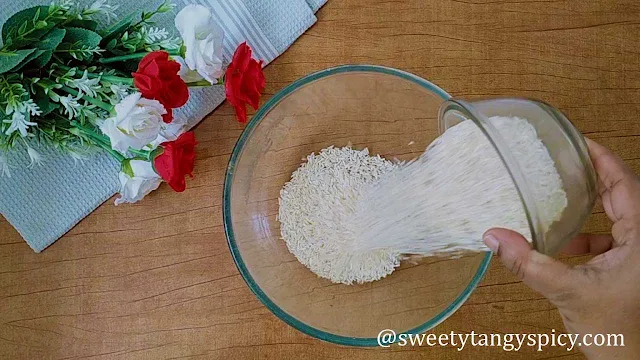

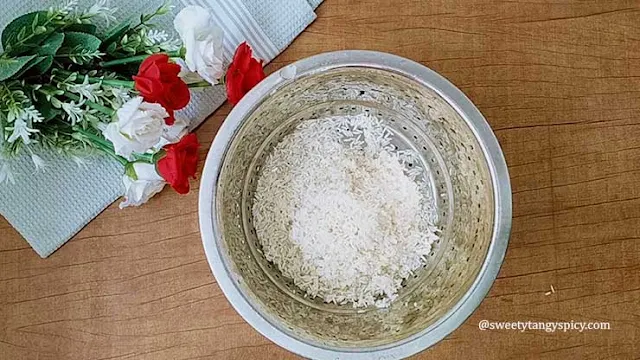

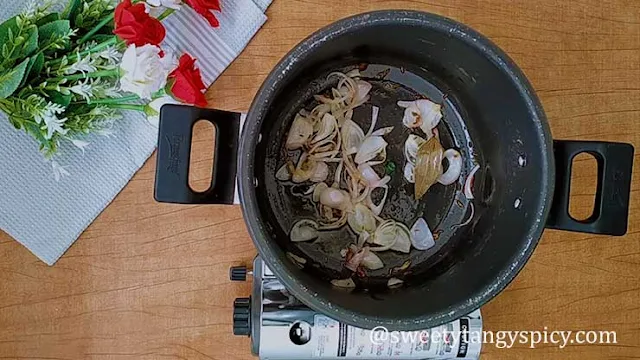




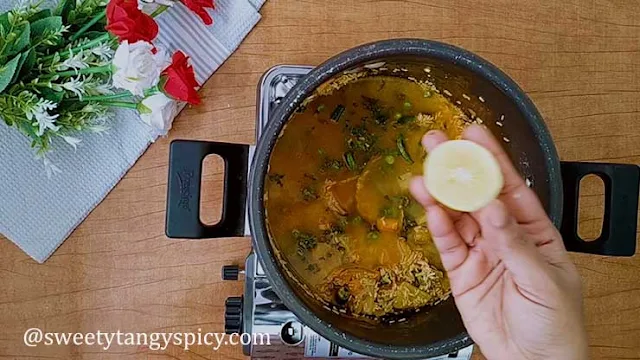



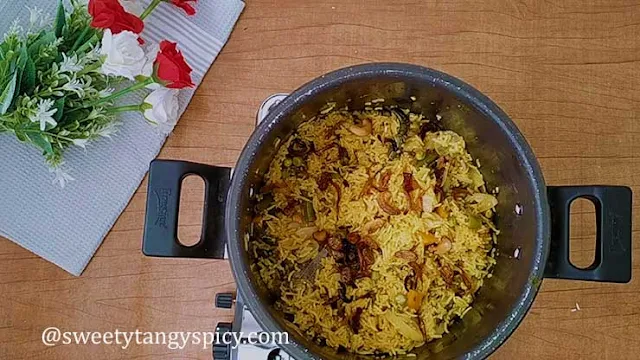



0 Comments